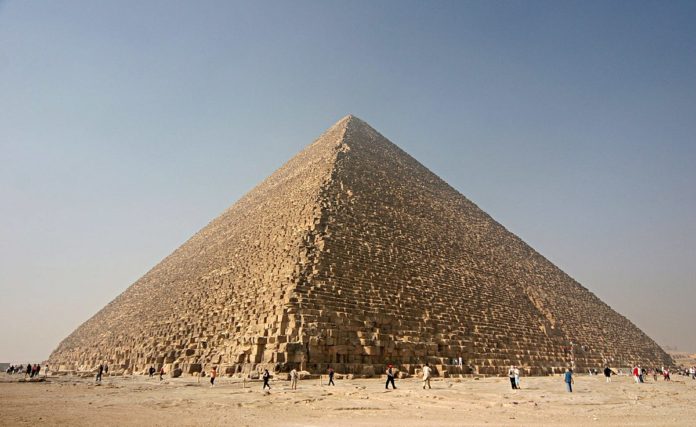Listed among the Seven Wonders of the traditional World, the Great Pyramid of Giza is perhaps the most famous structure discussed in ancient history. These massive monuments were inimitable in height for many millennia after their construction and still amaze and enthrall us with their overwhelming mass and seemingly impossible perfection. And yet we are still baffled on how they were built. We find these immense, mysterious, and fascinating structures throughout the world. We look at them in wonder and ask ourselves, who built them? How were they built? What were they used for? And when were they built? Standing at 400 ft tall on a rocky plateau, the Pyramid of Giza is located on the west bank of the Nile River. It stood as the tallest man-made structure on the planet for roughly over three millennia. This masterpiece of technical skill and engineering ability is not only the oldest monument of the ancient world but a puzzle to ponder.
These monumental tombs of “Egypt’s Old Kingdom” were constructed thousands of years ago. The pyramid age spans over 4,500 years, starting within the third dynasty and ending within the Second Intermediate Period. The pyramid was constructed by large work crews for over 3 generations of pharaohs. The structure had nearly 2.3 million blocks of limestone, each weighing about 2 tons, cut with precision, transported, and assembled to build the astonishing 5.75 million ton structure. A greek historian, Herodotus, was told that it took 100,000 men, 20 years to create the Great Pyramid of Giza. Today, however, scholars think it may have been built by 20,000 peasants for a little over 20 years. It was believed that Egypt’s pharaohs would become gods in their afterlife. To prepare for their life after death, they erected temples to different gods and built massive pyramid tombs for themselves. The tombs would contain all the things the pharaoh would need during their afterlife. The Great Pyramid of Giza belongs to a group of 3 large pyramids Khufu, Khafre, and Menkaure. The pyramids corresponded to the King for whom it was built. The pyramid was built for the 4th dynasty pharaoh, Khufu. It also contains smaller complexes for Khufu’s wife.
Many questions remain about the construction of those massive structures, and theories abound on the methods used. The workforce needed to create these monuments is additionally still much discussed. The discovery of a settlement of workers to the south of the plateau has offered scientists some answers. There were likely crews of skilled craftsmen and builders who were supplemented by seasonal crews of roughly 2,000 conscripted peasants who were divided into groups of 200 men. Experiments indicate that the group of 200 men were further divided into groups of 20 men who could haul 2.5-ton blocks from the quarry to the pyramid in about 20 minutes. Approximately 340 stones might be moved daily from the quarry to the construction site. The pyramids were presumably not built by slaves as slave labor was not widely used and very uncommon in Egypt at the time. Peasant farmers, however, were required to spend weeks performing these construction projects. This provided the paid labor needed to create these gigantic structures. During summer, since the fields were underwater, wages earned during the construction supplemented the family’s income.
There are many theories as to how the Great Pyramid of Giza was constructed. One theory suggests that causeways were used to haul stone blocks up the wooden sleds, located on the sides of the pyramids. The ramps were lubricated with water to scale back friction when hauling the blocks. As few as 10 men were needed to pull a stone bock up the ramp. There were several ramps, coiled around, on all sides of the pyramid at different levels. Once a stone block reached its desired level, wooden rockers were used to maneuver it into position.
The pyramid’s square base creates a very secure structure. Astronomical observations were used to align the corners of the pyramids with the four cardinal points. Approximately 80% of the building materials were found within the lower half of the pyramid. This means that comparatively fewer stone blocks were hauled to the upper levels. Since the pyramids are solid, no walls or pillars were required to support the structure. Despite its simple design, the pyramid is a structure with a fantastic engineering feat. Several theories have been attempted to explain how pyramids were constructed, but for now, the mysteries have yet to be solved.
With its splendid architecture and artwork resembling various fields of ancient Egyptian life to its attention-seeking culture and heritage, the Great Pyramid of Giza is irreplaceable. It is very important to preserve this structure that speaks the past with glory and power. Architecturally complex in design, the Great Pyramid of Giza is the world’s greatest architectural artifact.
By Sanjana Mahesh

















Nice article. Very informative
You did a really nice job!
It is fantastic and very informative excerpts. Keep it up.
Hi Sanjana,
I just finished reading your article “The Great Pyramid of Giza” and I want to tell you I appreciate your thorough research coverage and clear writing of the topic. Yours is a job well done!